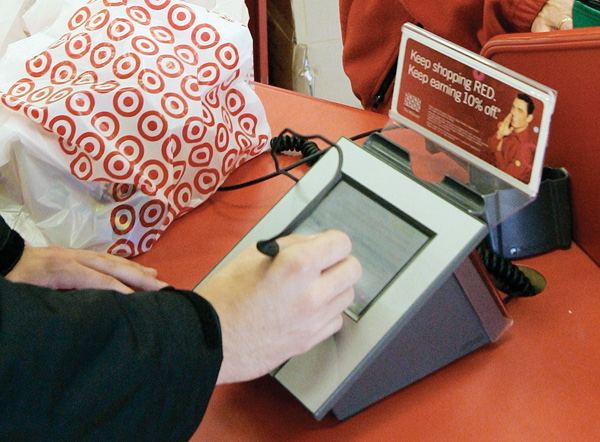CREDIT cards Weak US security made Target a big target


A customer signs his credit-card receipt at a Target store in Tallahassee, Fla. The U.S. is the juiciest target for hackers hunting credit-card information, and experts say incidents such as the recent data theft at Target’s stores will get worse before they get better.
Associated Press
NEW YORK
The U.S. is the juiciest target for hackers hunting credit-card information. And experts say incidents such as the recent data theft at Target’s stores will get worse before they get better.
That’s in part because U.S. credit and debit cards rely on an easy-to-copy magnetic strip on the back of the card, which stores account information using the same technology as cassette tapes.
“We are using 20th-century cards against 21st-century hackers,” says Mallory Duncan, general counsel at the National Retail Federation. “The thieves have moved on but the cards have not.”
In most countries outside the U.S., people carry cards that use digital chips to hold account information. The chip generates a unique code every time it’s used. That makes the cards more difficult for criminals to replicate. So difficult that they generally don’t bother.
“The U.S. is the top victim location for card-counterfeit attacks like this,” says Jason Oxman, chief executive of the Electronic Transactions Association.
The breach that exposed the credit-card and debit- card information of as many as 40 million Target customers who swiped their cards between Nov. 27 and Dec. 15 still is under investigation. It’s unclear how the breach occurred and what data, exactly, criminals have. Although security experts say no security system is fail-safe, there are several measures stores, banks and credit-card companies can take to protect against these attacks.
Companies haven’t further enhanced security because it can be expensive. And while global credit- and debit-card fraud hit a record $11.27 billion last year, those costs accounted for just 5.2 cents of every $100 in transactions, according to the Nilson Report, which tracks global payments.
Another problem: Retailers, banks and credit card companies each want someone else to foot most of the bill. Card companies want stores to pay to better protect their internal systems. Stores want card companies to issue more- sophisticated cards. And banks want to preserve the profits they get from older processing systems.
 43
43
